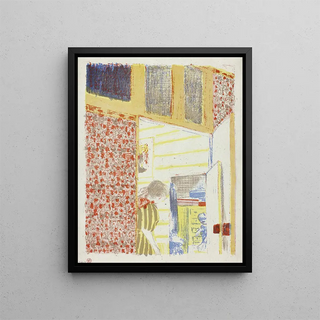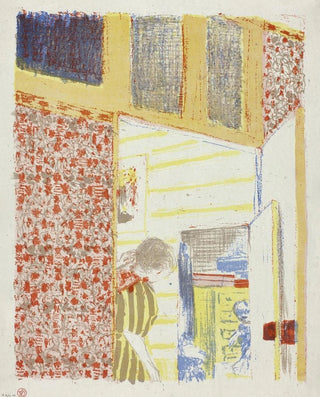Art print | Interior with pink wallpaper III - Édouard Vuillard


View from behind

Frame (optional)
The artwork "Interior with Pink Wallpaper III" by Édouard Vuillard is an invitation to delve into the intimate universe of the late 19th century. This painting, emblematic of the Nabi style, unfolds a warm and delicate atmosphere, where lines and colors blend in subtle harmony. The depiction of an interior, both everyday and precious, evokes a certain nostalgia while celebrating the beauty of fleeting moments. Through this piece, Vuillard offers us a poetic vision of domestic life, where every detail seems charged with meaning and emotion.
Style and uniqueness of the work
The originality of "Interior with Pink Wallpaper III" lies in how the artist plays with textures and patterns. The wallpaper, in a soft pink, bathes the scene in diffused light, creating a soothing ambiance. The characters, often depicted discreetly, blend into this space like delicate shadows, reflecting the intimacy of human relationships. Vuillard uses a limited yet expressive color palette, where shades of pink, beige, and green intertwine to evoke an atmosphere of serenity. His painting technique, both fluid and precise, captures light and reflections, while decorative motifs add a narrative dimension to the artwork. Every element, from furniture to fabrics, contributes to the composition of a rich tableau full of meaning, where the everyday becomes poetry.
The artist and his influence
Édouard Vuillard, an emblematic figure of the Nabi movement, knew how to leave his mark through his innovative approach to painting. Born in 1868 in Cuiseaux, his artistic journey is marked by encounters with other great names in art, such as Pierre Bonnard and Maurice Denis. Together, they sought to renew painting by moving away from academic conventions. Vuillard was particularly interested in the depiction of interiors, a subject that allowed him to explore themes of intimacy and family life. His influence extends beyond his era, inspiring many contemporary artists who see in him a precursor of modern Impressionism.

Matte finish

View from behind

Frame (optional)
The artwork "Interior with Pink Wallpaper III" by Édouard Vuillard is an invitation to delve into the intimate universe of the late 19th century. This painting, emblematic of the Nabi style, unfolds a warm and delicate atmosphere, where lines and colors blend in subtle harmony. The depiction of an interior, both everyday and precious, evokes a certain nostalgia while celebrating the beauty of fleeting moments. Through this piece, Vuillard offers us a poetic vision of domestic life, where every detail seems charged with meaning and emotion.
Style and uniqueness of the work
The originality of "Interior with Pink Wallpaper III" lies in how the artist plays with textures and patterns. The wallpaper, in a soft pink, bathes the scene in diffused light, creating a soothing ambiance. The characters, often depicted discreetly, blend into this space like delicate shadows, reflecting the intimacy of human relationships. Vuillard uses a limited yet expressive color palette, where shades of pink, beige, and green intertwine to evoke an atmosphere of serenity. His painting technique, both fluid and precise, captures light and reflections, while decorative motifs add a narrative dimension to the artwork. Every element, from furniture to fabrics, contributes to the composition of a rich tableau full of meaning, where the everyday becomes poetry.
The artist and his influence
Édouard Vuillard, an emblematic figure of the Nabi movement, knew how to leave his mark through his innovative approach to painting. Born in 1868 in Cuiseaux, his artistic journey is marked by encounters with other great names in art, such as Pierre Bonnard and Maurice Denis. Together, they sought to renew painting by moving away from academic conventions. Vuillard was particularly interested in the depiction of interiors, a subject that allowed him to explore themes of intimacy and family life. His influence extends beyond his era, inspiring many contemporary artists who see in him a precursor of modern Impressionism.






